There are usually two strategies for detecting infectious diseases: detection of the pathogen itself or detection of antibodies produced by the human body to resist the pathogen. Detection of pathogens can detect antigens (usually surface proteins of pathogens, some use internal nuclear proteins). You can also test nucleic acids. If any one of nucleic acid, antigen and antibody is detected in the patient's body fluid, it means that he has been infected.
Nucleic acid detection: high requirements for laboratory environment, testing personnel, instruments, etc., high detection sensitivity, good specificity, generally 2-3 hours results. Antibody detection: the operation is simple and convenient, suitable for a large number of suspected cases and stateless infection detection, the fastest result is within 15 minutes. Antigen detection: low laboratory requirements, can be used for early screening, early diagnosis, suitable for large-scale screening in primary hospitals, the fastest results within 15 minutes. At present, nucleic acid detection is widely used, the sensitivity and specificity of antibody and antigen detection reagents are limited, each has its own emphasis, and can not replace each other. The combined application of multiple detection methods can effectively shorten the detection window period and improve the positive detection rate. If you need antigen and antibody detection new crown, please contact us, we have efficient detection products.


Post time: Dec-22-2020

